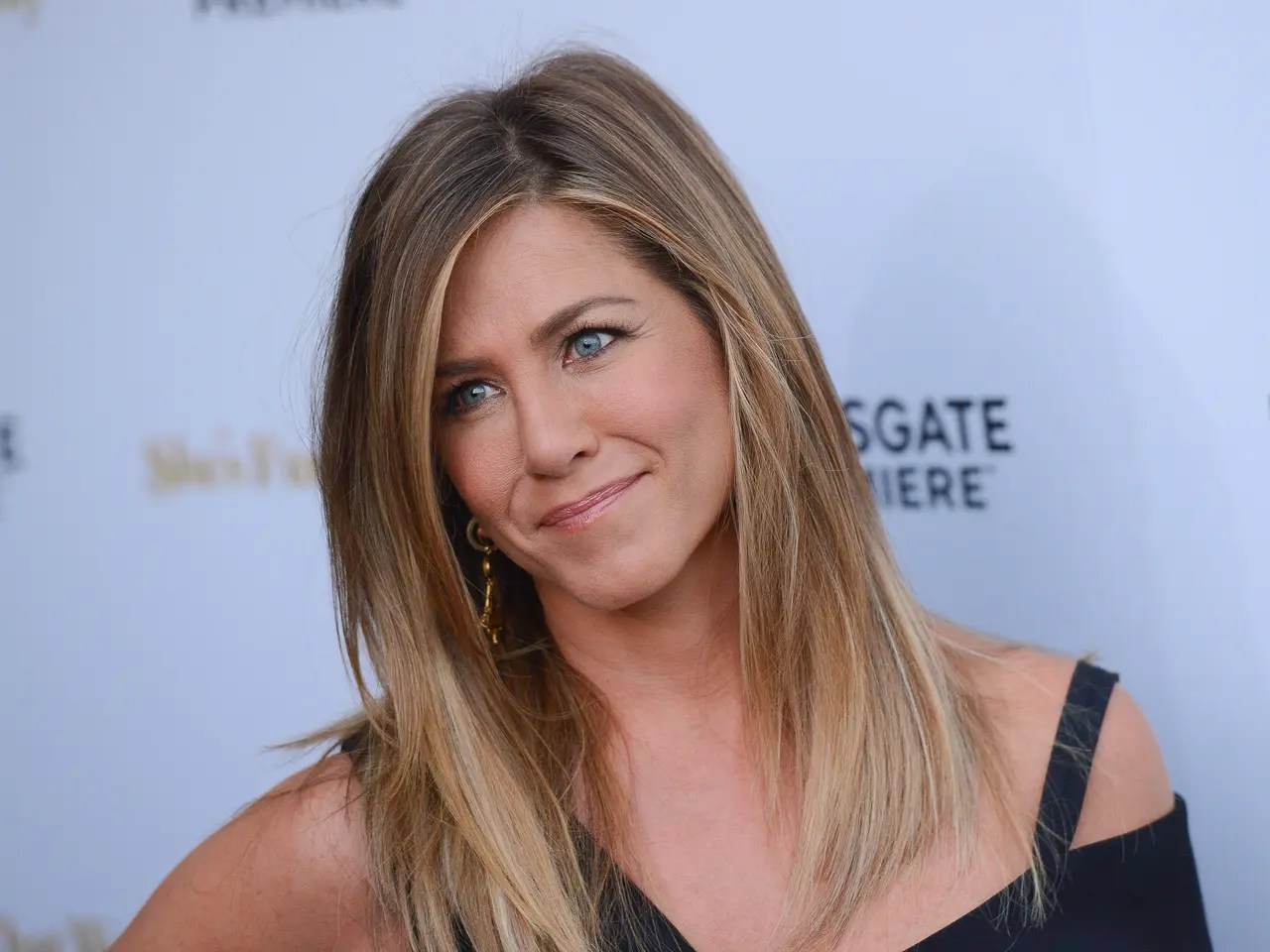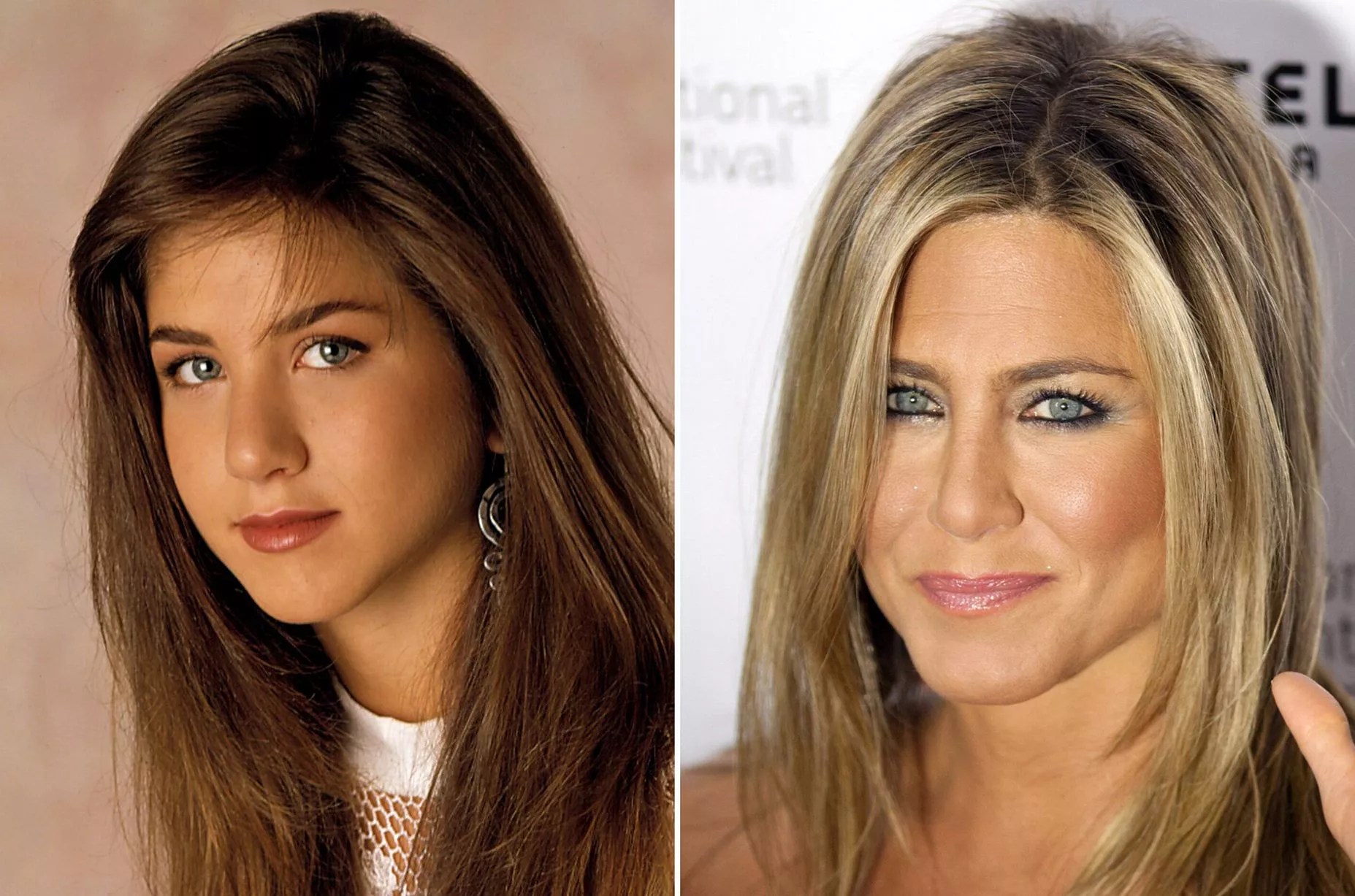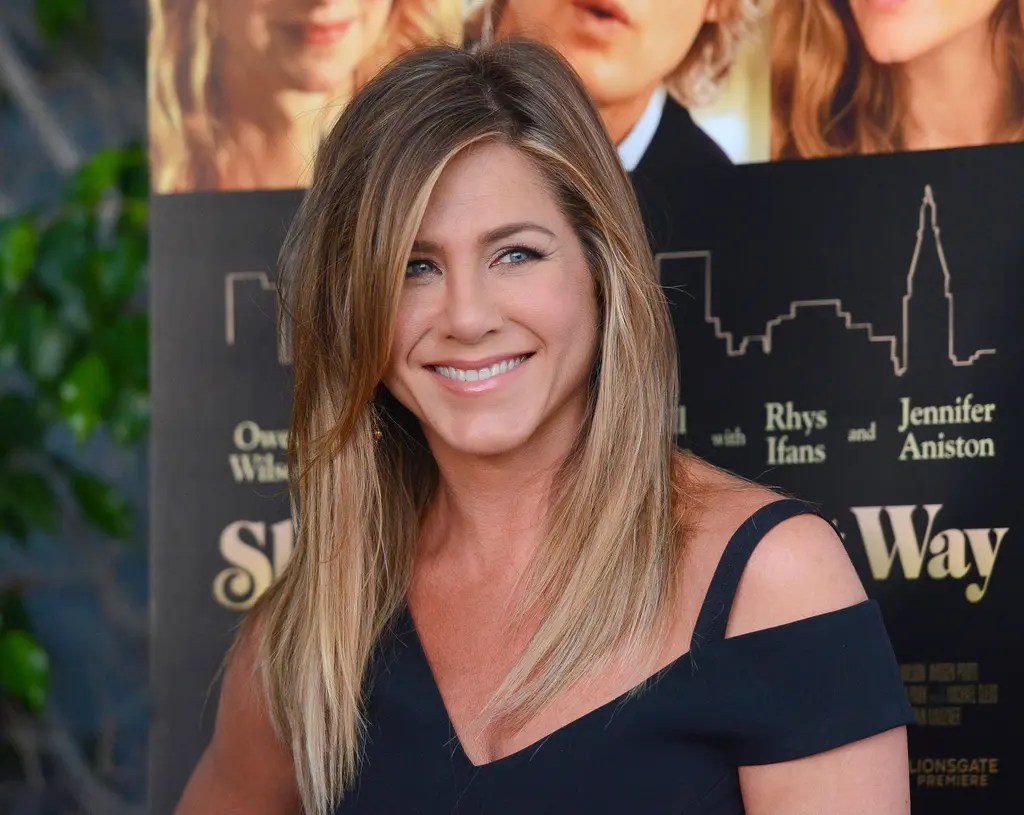Jennifer Aniston Plastic Surgery refers to the cosmetic procedures that the American actress has undergone to enhance her appearance. For instance, she has reportedly had rhinoplasty, breast augmentation, and Botox injections.
Celebrity plastic surgery is a common topic of interest and discussion, as it relates to issues of body image, aging, and the pursuit of beauty. While some may question the ethics of altering one's physical appearance, others view it as a personal choice and a way to boost self-confidence.
The history of plastic surgery dates back to ancient Egypt, where surgeons used rudimentary techniques to repair injuries and reconstruct facial features. Over the centuries, the field has evolved significantly, with the development of new technologies and procedures. Today, plastic surgery is an integral part of the healthcare system, offering a wide range of options for both cosmetic and reconstructive purposes.
Jennifer Aniston Plastic Surgery
Jennifer Aniston's plastic surgery is a topic of interest due to its implications for body image, aging, and the pursuit of beauty. Key aspects to consider include:
- Procedure types: Rhinoplasty, breast augmentation, Botox
- Motivations: Personal choice, career pressures
- Benefits: Enhanced appearance, boosted confidence
- Risks: Complications, dissatisfaction
- Ethics: Concerns about authenticity, societal expectations
- Public perception: Scrutiny, judgment
- Media influence: Portrayal of ideal beauty standards
- Historical context: Evolution of plastic surgery techniques
- Celebrity culture: Pressure to conform to unrealistic standards
These aspects are interconnected and complex. For instance, the media's portrayal of beauty standards can influence individuals' motivations for plastic surgery, while public perception can shape the ethical considerations surrounding the practice. Understanding these aspects provides a more nuanced perspective on Jennifer Aniston's plastic surgery and its broader implications.
Personal Details and Bio Data of Jennifer Aniston
| Name: | Jennifer Aniston |
| Date of Birth: | February 11, 1969 |
| Place of Birth: | Sherman Oaks, California, U.S. |
| Occupation: | Actress, producer, businesswoman |
| Known for: | Rachel Green in Friends |
Procedure types
The specific procedures that Jennifer Aniston has reportedly undergone, including rhinoplasty, breast augmentation, and Botox injections, offer a glimpse into the diverse range of options available within the realm of cosmetic surgery. These procedures address different aspects of facial and body aesthetics, highlighting the multifaceted nature of plastic surgery as a means to enhance appearance and potentially boost self-confidence.
- Rhinoplasty
Rhinoplasty, commonly known as a nose job, involves reshaping the nose to improve its size, shape, or function. It can address concerns such as a hump or bump on the bridge, a wide or narrow nasal tip, or breathing difficulties.
- Breast augmentation
Breast augmentation involves surgically increasing the size of the breasts using implants. This procedure is often sought to enhance breast volume, improve symmetry, or correct developmental abnormalities.
- Botox injections
Botox is a neuromodulator that temporarily relaxes facial muscles. It is commonly used to reduce the appearance of wrinkles and fine lines, particularly in the forehead, around the eyes, and between the eyebrows.
The choice of specific procedures often depends on individual needs, goals, and the surgeon's assessment. In Jennifer Aniston's case, these procedures have reportedly contributed to her youthful and radiant appearance, showcasing the potential of plastic surgery to enhance one's physical attributes and potentially boost self-esteem.
Motivations
Jennifer Aniston's decision to undergo plastic surgery was likely influenced by both personal choice and career pressures. As a prominent actress in Hollywood, she operates in an industry that places a high value on physical appearance. The pressure to maintain a youthful and attractive image may have played a role in her decision to seek cosmetic enhancements.
At the same time, Aniston has also expressed a desire to feel confident and comfortable in her own skin. Plastic surgery can be a way for individuals to address insecurities and enhance their self-esteem. In Aniston's case, her decision to undergo plastic surgery may have been motivated by a combination of personal and professional factors.
The connection between "Motivations: Personal choice, career pressures" and "jennifer aniston have plastic surgery" is significant because it highlights the complex factors that can influence an individual's decision to undergo cosmetic surgery. While personal choice is often a primary motivator, external pressures, such as societal expectations or career demands, can also play a role.
Understanding the motivations behind plastic surgery can help us to better understand the choices that individuals make about their own bodies. It can also help us to challenge unrealistic beauty standards and to promote a more accepting and inclusive society.
Benefits
Jennifer Aniston's plastic surgery has reportedly provided her with enhanced appearance and boosted confidence. These benefits are closely intertwined and can have a significant impact on an individual's overall well-being.
- Improved Physical Appearance
Plastic surgery can address physical concerns or insecurities, leading to a more positive body image. For instance, rhinoplasty can improve the shape and size of the nose, while breast augmentation can enhance breast volume and symmetry.
- Increased Self-Esteem
When individuals feel good about their appearance, it can translate into increased self-esteem and confidence. Cosmetic procedures can help individuals to feel more attractive and desirable, which can lead to a more positive self-image.
- Enhanced Social Interactions
A more positive body image and increased self-confidence can lead to improved social interactions. Individuals may feel more comfortable and outgoing in social situations, leading to stronger relationships and a more fulfilling social life.
- Career Advancement
In some cases, plastic surgery can provide career benefits, particularly in industries that value physical appearance. For example, actors and models may benefit from cosmetic enhancements that improve their on-screen presence or overall image.
These benefits highlight the potential positive impact that plastic surgery can have on an individual's life. However, it is important to note that the decision to undergo plastic surgery should be carefully considered, and individuals should be fully informed of the potential risks and benefits involved.
Risks
While plastic surgery can offer potential benefits, it is important to acknowledge the associated risks and potential for dissatisfaction. In the case of Jennifer Aniston's plastic surgery, there are several key aspects to consider:
- Surgical Complications
All surgeries carry some degree of risk, including infection, bleeding, and scarring. In the case of plastic surgery, specific complications can vary depending on the procedure performed.
- Unnatural Appearance
Plastic surgery aims to enhance appearance, but there is a risk of achieving an unnatural or artificial look. This can occur if the surgery is performed excessively or if the results do not align with the patient's expectations.
- Dissatisfaction and Regret
Even if a plastic surgery procedure is technically successful, there is a possibility that the patient may experience dissatisfaction or regret. This can stem from unrealistic expectations, changes in personal preferences, or simply the realization that surgery cannot fully address underlying issues related to body image.
- Long-Term Effects
The long-term effects of plastic surgery are not always fully known. Some procedures may require revision surgeries or ongoing maintenance to maintain the desired results. Additionally, the aging process can impact the outcome of plastic surgery, leading to changes in appearance over time.
These risks and potential for dissatisfaction should be carefully considered before undergoing any plastic surgery procedure. It is crucial to have realistic expectations, thoroughly research the procedure and surgeon, and weigh the potential benefits against the risks involved.
Ethics
The connection between "Ethics: Concerns about authenticity, societal expectations" and "jennifer aniston have plastic surgery" lies in the potential impact of plastic surgery on an individual's sense of self and the broader societal norms surrounding beauty and appearance.
Those who argue against plastic surgery on ethical grounds often raise concerns about the erosion of authenticity and the perpetuation of unrealistic beauty standards. They argue that plastic surgery can lead to individuals feeling pressured to conform to narrow and often unattainable ideals, potentially undermining their self-esteem and sense of identity. Additionally, critics argue that the widespread acceptance of plastic surgery can contribute to a culture that values superficiality and places excessive emphasis on physical appearance.
Real-life examples of ethical concerns surrounding Jennifer Aniston's plastic surgery include the scrutiny and judgment she has faced in the media and public discourse. Some critics have questioned the authenticity of her appearance, suggesting that her beauty is the result of surgical enhancements rather than natural aging. This type of commentary highlights the societal expectations placed on women, particularly celebrities, to maintain a youthful and attractive appearance.
Understanding the ethical implications of plastic surgery is crucial for individuals considering cosmetic procedures. It is essential to approach plastic surgery with realistic expectations and a clear understanding of one's motivations for seeking such procedures. Ethical considerations should be weighed against the potential benefits and risks of plastic surgery, ensuring that decisions are made in alignment with one's values and overall well-being.
Public perception
Public perception and scrutiny are closely intertwined with the topic of "jennifer aniston have plastic surgery". The connection stems from the heightened attention and judgment that celebrities face regarding their physical appearance. In Aniston's case, her status as a prominent actress has subjected her to intense media scrutiny and public commentary on her plastic surgery.
Scrutiny and judgment can have a significant impact on individuals who undergo plastic surgery. The constant evaluation and critique can lead to feelings of self-consciousness, anxiety, and even depression. In Aniston's case, public scrutiny has been a double-edged sword. While it has undoubtedly contributed to her fame and success, it has also subjected her to intense pressure and criticism.
One practical application of understanding the connection between public perception and plastic surgery is the need for individuals to carefully consider the potential consequences before undergoing any procedures. The decision to have plastic surgery should be a personal one, based on the individual's own goals and aspirations. It is crucial to be aware of the potential for public scrutiny and judgment and to have a strong support system in place to cope with any negative attention.
Media influence
The influence of the media in portraying ideal beauty standards is closely linked to the topic of "jennifer aniston have plastic surgery". The media, through various channels such as magazines, television, and social media, plays a significant role in shaping societal perceptions of beauty and attractiveness. In the case of Aniston, her status as a celebrity and public figure has made her appearance a subject of intense media scrutiny and commentary.
- Unrealistic expectations
The media often portrays a narrow and unrealistic ideal of beauty, which can create unrealistic expectations for individuals. Constant exposure to images of celebrities and models who have undergone plastic surgery can lead to a distorted perception of what is considered "normal" or attractive.
- Body dissatisfaction
The media's portrayal of idealized beauty standards can contribute to feelings of body dissatisfaction and low self-esteem. Individuals may compare themselves to these images and feel inadequate or unattractive, leading them to consider plastic surgery as a means to achieve the desired look.
- Celebrity culture
Celebrity culture plays a significant role in perpetuating unrealistic beauty standards. Celebrities are often idolized and their physical attributes are held up as the epitome of beauty. This can create a sense of pressure for celebrities to conform to these standards, potentially leading them to seek plastic surgery to maintain or enhance their appearance.
- Objectification of women
The media's portrayal of women often objectifies and sexualizes their bodies. This objectification can reinforce the idea that women's value is primarily based on their physical appearance, which can contribute to feelings of insecurity and a desire to alter one's body to meet societal expectations.
These facets of media influence highlight the complex and multifaceted ways in which the media shapes perceptions of beauty and can influence decisions about plastic surgery. Understanding these influences is crucial for individuals considering plastic surgery, as it can help them to make informed decisions based on their own values and aspirations rather than societal pressures.
Historical context
Within the context of "jennifer aniston have plastic surgery", understanding the historical evolution of plastic surgery techniques provides valuable insights into the motivations, methods, and implications of cosmetic surgery. This evolution has shaped the types of procedures available, the outcomes that can be achieved, and the ethical considerations surrounding plastic surgery.
- Ancient Origins
Plastic surgery has roots in ancient civilizations, with evidence of reconstructive procedures in Egypt as early as 3000 BC. These early techniques focused on restoring form and function after injuries or disfigurements.
- Renaissance Advancements
During the Renaissance, plastic surgery techniques advanced significantly, particularly in Italy. Surgeons began to develop new methods for repairing facial defects, using techniques that would later form the basis of modern rhinoplasty.
- 19th Century Innovations
The 19th century witnessed major advancements in anesthesia and surgical techniques. These innovations allowed for longer and more complex surgeries, expanding the scope of plastic surgery to include both reconstructive and cosmetic procedures.
- 20th Century Refinements
The 20th century saw the development of specialized plastic surgery techniques, such as microsurgery and laser surgery. These advancements enabled surgeons to perform more precise and delicate procedures, leading to improved outcomes and reduced scarring.
The historical evolution of plastic surgery techniques has played a crucial role in shaping the field as we know it today. Jennifer Aniston's plastic surgery, like that of many individuals, reflects the culmination of centuries of advancements in surgical techniques and medical knowledge, allowing for the enhancement of appearance and the correction of physical concerns.
Celebrity culture
Within the context of "jennifer aniston have plastic surgery", the aspect of "Celebrity culture: Pressure to conform to unrealistic standards" holds significant relevance. The glamorous and often-scrutinized lives of celebrities can create immense pressure to maintain a certain image, leading to the pursuit of cosmetic enhancements to meet societal expectations.
- Constant Media Scrutiny
Celebrities are under constant media scrutiny, with their physical appearance often being a primary focus. This intense attention can foster a sense of self-consciousness and a desire to conform to prevailing beauty standards.
- Social Media Influence
Social media platforms provide a constant stream of images showcasing idealized appearances, which can influence celebrities' perceptions of what is considered attractive and desirable.
- Fan Expectations
Celebrities often feel pressure to meet the expectations of their fans, who may have unrealistic standards of beauty. This pressure can drive celebrities to seek plastic surgery to maintain or enhance their appearance.
- Competition Within the Industry
Within the entertainment industry, there is a competitive environment where celebrities may feel the need to undergo plastic surgery to stay relevant and maintain their status.
The pressure to conform to unrealistic standards can have detrimental effects on celebrities' mental health and self-esteem. It can also perpetuate unrealistic beauty ideals within society, contributing to body dissatisfaction and low self-worth among individuals who compare themselves to these images.
In exploring the topic of "jennifer aniston have plastic surgery", this article has delved into various interconnected aspects, providing insights into the motivations, benefits, risks, and ethical considerations surrounding cosmetic surgery. Key points that emerge from this exploration include:
- The decision to undergo plastic surgery is complex, influenced by both personal and societal factors.
- While plastic surgery can offer potential benefits such as enhanced appearance and boosted confidence, it is essential to carefully consider the risks and limitations involved.
- The media and celebrity culture play a significant role in shaping societal beauty standards and can contribute to pressures for individuals to conform to unrealistic ideals.
The topic of "jennifer aniston have plastic surgery" highlights the need for critical engagement with societal norms and expectations surrounding appearance. It encourages individuals to make informed decisions about their bodies and to challenge unrealistic beauty standards that can negatively impact self-esteem and well-being.
Josh brolins dad
Robert downey jr husband
Does mariska hargitay have a biological child



ncG1vNJzZmino5ius4KXZ6qfp2JjsaqzyK2YpaeTmq6vv8%2Bamp6rXpi8rnvJnqWnoZaav26tzaKqraeeYrWiwsRmp6WZo6m2pHnSrqmgnaKue6nAzKU%3D